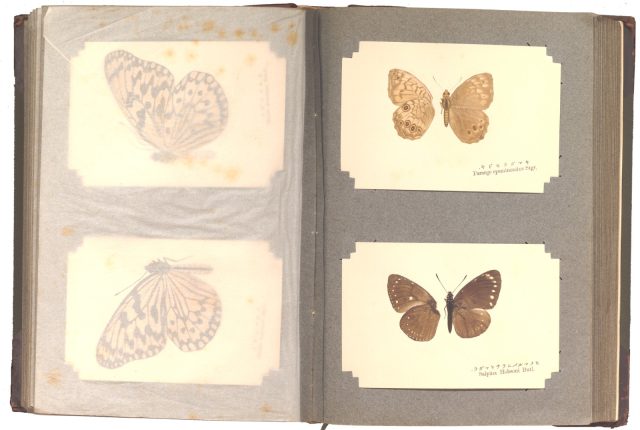
Date/Time
Friday, May 17, 2024
9:15 am PDT – 5:30 pm PDT
Location
UCLA William Andrews Clark Memorial Library & via Livestream
2520 Cimarron Street
Conference organized by Anna Chen, Rebecca Fenning Marschall, and Bronwen Wilson, University of California, Los Angeles
The early modern period was a hothouse for the study of physical things in the natural world, and for the collection and assembly of them in human-made physical spaces. In other periods, botanical samples were preserved by diarists in their journals, such as Poems and Riddles written by Mary Woodyeare Tibbits (ca. 1764–1840), and Pressed specimens of butterflies and moths (1905), compiled by Yasushi Nawa (1857–1926), which are both in the Clark Library’s collections. Nawa’s lepidochromic book showcases the technique of “printing butterflies,” or fixing the scales of their wings onto paper. Specimens of all sorts were admired for their variegated colors, curated in collections, and assembled into books. Birds were captured in aviaries for their sounds, or killed and prepared as specimens for display, study, and scientific descriptions. Plants were transported across oceans in terraria, and contained in plots and glasshouses.
Libraries were deeply implicated in these historical pursuits of the collection and classification of the contents of the natural world, as are modern libraries that now grapple with whether and how to preserve the nature that enters their collections. The interior-exterior division of libraries is a highly regulated boundary. Libraries strive tirelessly to seal the building envelope against the environmental conditions of the outdoors, as fluctuating temperature and humidity levels, mold spores, insects, rodents and natural disasters all threaten damage to their holdings. Libraries also capture books about nature on their shelves, as flora and fauna cohabitate on their grounds. At the Clark Library, Cooper hawks nest, feral cats roam, and roots of trees probe the ground in search of water. What might we learn from these efforts to capture and to conserve nature, coupled with its potential to decompose or to invade environments?
Speakers
Frederico Câmara, Independent Researcher
Ashley Cataldo, American Antiquarian Society
Tori Champion, University of St. Andrews
Cynthia Fang, University of California, Los Angeles
David Jones, Northwestern University
V.E. Mandrij, University of Konstanz / University of Amsterdam
Deirdre Madeleine Smith, University of Pittsburgh & Carnegie Museum of Natural History
Lindsay Wells, Independent Scholar
Andrew Weymouth, University of Idaho
Jennifer Martinez Wormser, Ella Strong Denison Library, Scripps College
Joy Zhu, University of California, Los Angeles
For a list of sources at the Clark Library, please see here.
Program Schedule
All times listed in Pacific Daylight Time
For each speaker’s Abstract & Biography, please click on their name below.
9:15 a.m.
Introduction
Anna Chen, Rebecca Fenning Marschall, and Bronwen Wilson, University of California, Los Angeles
9:30 a.m.
Panel 1: Flight and Containment
Moderator: Rebecca Fenning Marschall, University of California, Los Angeles
Cynthia Fang, University of California, Los Angeles
“Containing Sound, Exhibiting Images: An Aviary at the European Palace Complex in Qing China”
9:50 a.m.
V. E. Mandrij, University of Konstanz / University of Amsterdam
“The Lepidochromy Technique: Capturing Colors of Butterflies and Moths in Books and Paintings”
10:10 a.m.
Jennifer Martinez Wormser, Ella Strong Denison Library, Scripps College
“One Hundred Years Later: Ellen Browning Scripps and William Leon Dawson’s Birds of California (1923)”
10:30 a.m.
Discussion
11:00 a.m.
Coffee break
11:30 a.m.
Panel 2: Accretions
Moderator: Anna Chen, University of California, Los Angeles
Tori Champion, University of St. Andrews
“Material Afterlives: The Shell Craze in Eighteenth-Century France and the Forgotten Mollusc”
11:50 a.m.
Joy Zhu, University of California, Los Angeles
“Misinterpreting Fossil Evidence: On the Discovery of ’Dragon Fossils‘ in China (1915-1930)”
12:10 p.m.
Andrew Weymouth, University of Idaho
“Humanizing Nature Research History with Static Web Design”
12:30 p.m.
Discussion
1:00 p.m.
Lunch
Display of Clark Library materials in the North Book Room
2:30 p.m.
Panel 3: Unruly Collections
Moderator: Rebecca Fenning Marschall, University of California, Los Angeles
David Jones, Northwestern University
“In However Low Degree: Reframing the Role of Silverfish in Louis Fleckenstein’s Photography”
2:50 p.m.
Ashley Cataldo, American Antiquarian Society
“From Weeding to Reseeding: Removing (and Restoring) Botanicals in Library Collections”
3:10 p.m.
Deirdre Madeleine Smith, University of Pittsburgh & Carnegie Museum of Natural History
“Whither ‘Papered Leps’: On Accidental Human Archives at the Carnegie Museum of Natural History”
3:30 p.m.
Discussion
4:00 p.m.
Coffee break
4:30 p.m.
Panel 4: Assembling
Moderator: Bronwen Wilson, University of California, Los Angeles
Lindsay Wells, Independent Scholar
“Portrait of a Colonial Botanist: Joseph Dalton Hooker and the Visual Politics of Plant Science”
4:50 p.m.
Frederico Câmara, Independent Researcher
“Views of Paradise: A Photographic Atlas of the Artificial Environments of Zoological Gardens and Aquariums in Oceania”
5:10 p.m.
Discussion
5:30 p.m.
Program concludes
The conference is free to attend with advance registration, and will be held in-person at the Clark Library and livestreamed on the Center’s YouTube Channel. No registration is required to watch the livestream. In-person registration will close on Monday, May 13 at 5:00 p.m. Seating is limited at the Clark Library; walk-in registrants are welcome as space permits.
Image: Photograph of book: Pressed specimens of butterflies and moths (1905), compiled by Yasushi Nawa, courtesy of Clark Library collections

